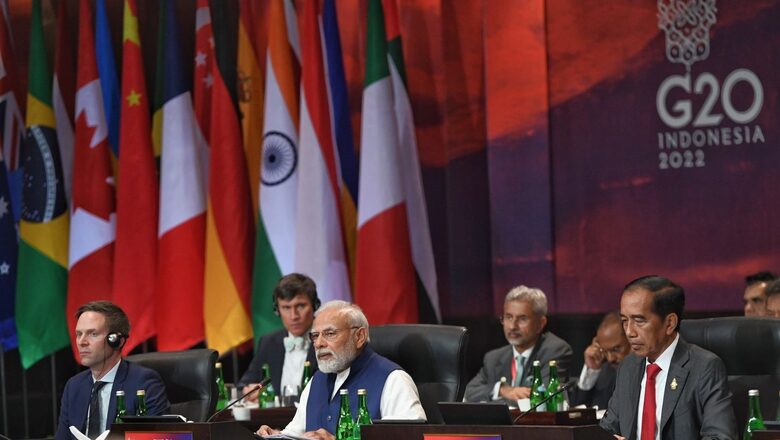
views
As the year 2022 bids goodbye, the words of Indian Prime Minister Narendra Modi that “it is not an era of war” are reverberating across the world. When PM Modi gave his piece of mind to India’s good friend Vladimir Putin over Russia’s war on Ukraine, little did anybody know that India will become a choice of preference for mediating peace between the two countries, but this is exactly what India has earned for itself this year. While the war is still going on, Ukrainian President Volodymyr Zelenskyy has already shown where he places his hopes. “Now, I count on India,” he stated in a telephonic conversation with PM Modi last week.
2022 was a special year for India in many ways. Since 2014, India under the leadership of Narendra Modi, openly declared its ambitions to be a leading power. This is very different from the West, which perceives India as a balancing power to manage China’s rise. In order to pursue its goal of a leading power, India has also articulated its vision of a multipolar world, repeatedly at many forums. This year has brought significant progress for India’s ambitions. I am going to count here 5.
One of the most significant achievements for India this year was its entry into the club of Big-5 economies. As India was celebrating its 75th anniversary of independence from the British, it also overtook its former coloniser to become the fifth-largest economy in the world. This was big. Just a decade ago, India was 11th in global economic rankings while the UK was 5th. Off late, India has emerged as the most resilient economy earning the status of fastest growing economy in the world. By clocking a GDP of $3.53 trillion this year, India has cleared the decks to become a $5 trillion economy by the mid-2020s.
Another plus for India this year was the way it negotiated its interests during the Russia-Ukraine war despite pressure from the Western countries to join them in reprimanding Russia. For all practical purposes, India’s defence sector is still dominated by Russia with which it also shares a long-term vision of a multipolar Asia and a multipolar world. India was shamed, criticised and even the Kashmir card was played but the country held its own. It not only benefitted from buying the discounted Russian oil but also strengthened its position as an independent pole. India stood vindicated when the Western powers continued to engage the country but on its own terms.
However, not everything worked out in India’s favour this year and its biggest example is the Chinese incursions across the Line of Actual Control (LAC). In fact, in the last month, India faced Chinese aggression in Tawang, marking the first episode of significant violence between the two countries since the 2020 Galwan Valley clash. One can only expect these skirmishes to increase as China is employing deceptive tactics where it is claiming that the border situation is stable – officially — but is using LAC incursions to keep India off-balance. China is suffering from the ‘middle kingdom’ syndrome and that requires it to check India’s rise for which an unstable LAC is one of its best bets. But India has also spotted this evil design. In 1993, India under PV Narasimha Rao had delinked its overall equation with China from the situation at the border through the Peace and Tranquility Agreement. However, 2022 marked the year when India relinked the two. External Affairs Minister Dr S Jaishankar articulated this clearly when he said that relations between the two countries aren’t normal and won’t be until the aggression on the border continues. He specifically noted that working out any arrangement with China is difficult after 2020 and it will be sustainable only if three mutuals are met — mutual respect, mutual sensitivity and mutual interest.
While in the case of China, reality has dawned on India regarding China’s lead over the country in terms of national power and its position on the border, India is also realising the need for seeking multiple partnerships to balance China in the short term. Its most important partnership is with the United States to this effect. While India registered a protest against the Chinese docking of the Yuan Wang-5 ship at the Hambantota port, it, for the first time, allowed a US Navy War Ship to dock at India’s Kattupalli shipyard for repair work this year. The strategic significance of this move is huge as it marked a new era of bilateral cooperation between the US and India. Their bilateral trade is also going from strength to strength, crossing the $100 billion mark in 2021 and reaching $157 billion in 2022. The US surpassed China as India’s largest trade partner in FY2022 and this year also marked a significant boost in their cooperation in the technology domain with the launching of the Initiative on Critical and Emerging Technologies (iCET) for partnership in strategic technology sectors.
Meanwhile, in the neighbourhood, India continued to display new-found confidence and dynamism. It emerged as the first responder when a severe economic crisis broke out in Sri Lanka and extended the largest share of assistance at around $4 billion. This has created a lot of goodwill for India leading the Sri Lankans to seek Indian investments for strategic projects. This will be a huge opportunity for India to blunt off the Chinese edge in the Island country, provided it deals its cards smartly. India has also shown remarkable maturity and greater awareness of its interests in engaging Taliban 2.0 which had returned to Afghanistan in 2021. India upgraded its diplomatic presence in the country by sending diplomats to Kabul on humanitarian grounds. But there’s clearly a well-crafted logic behind this, of denying any strategic depth to Pakistan (and China), this time around.
2022 proved to be a key year for India’s growing ambitions as a leading power and its willingness to be a player on the global chessboard. 2023 will definitely bring more opportunities for India to display its newfound voice in the global scheme of things as the year will also mark India’s G20 Presidency. Let’s hope India’s economic ascendance gains a faster pace to make its aspirations reach closer to reality in the year 2023.
The author is a PhD in International Relations from the Department of International Relations, South Asian University. Her research focuses on political economy of South Asia and regional integration. Views are personal.
Read all the Latest Opinions here

















Comments
0 comment